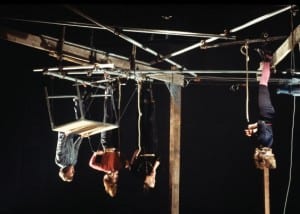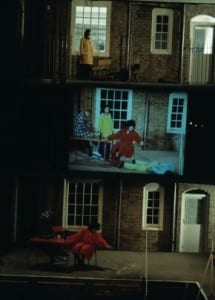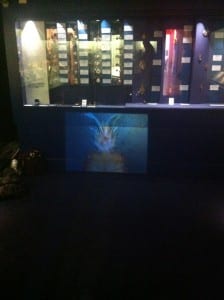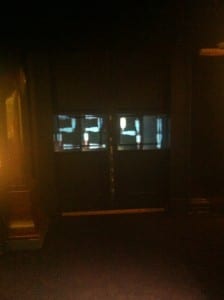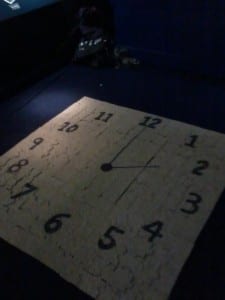“All rooted in an interest to make work that brings together theatre and the visual arts in a single unified vision” (Station House Opera, 2013).
Station House Opera are a site specific orientated theatre company based in the United Kingdom. When looking over their archived work, the thing which I found the most intriguing was their extensive use of multi-media, as it was something which we experimented within our piece. The pieces of work which I found particularly fascinating when comparing them to ours were that of their Ultramundane, Snakes and Ladders and Backwards.
Ultramundane’s intention was to present the public with an “inversion of the world” (Station House Opera, 1983) which they know so well. They intended for their performers to be “physically together yet dramatically separate, for they belonged to different parts of the landscape” (1983). This is something which we experimented with within our site specific performance. Although we were all close in proximity, we were apart in terms of aesthetical ease. The costumes we used represented a specific part of the day, so each ‘character’ would make sense at one point during the day, whilst the remaining five would continue to look out of place until they had found their specific ‘setting’. This parallels Station House Opera’s idea of characters belonging to different parts of the landscape.
Their use of multimedia appears to be most present in their 1998 production Snakes and Ladders. Snakes and Ladders “traced the external signs of an invisible dialogue between mind and matter” (Station House Opera, 1998). The performers on stage were accompanied by doubles of themselves presented in a video projection format. This is similar to the fact that we used ourselves to create our human clock projection, as we are essentially removing the ‘characters’ from world, into another. By mixing the virtual world with the actual you see two different interpretations of a person. In the recreated image you see a person who can not experience emotion or danger, but in the actual world you see the aftermath, the effects on the performers.
One of their more recent works Backwards (2010) explores the notion of time, with a particularly strong focus on the notion of the distorted. “Do we believe in progress? Do we have evidence that humans improve? Evolution may operate in time, but our sensibilities do not. We must no longer see the world as one damn thing after another” (Station House Opera, 2010). We explored a similar issue within our performance, hoping that watching us would cause the audience to ask themselves similar questions to those seen above. Backwards starts at the end of a day and reverses back to the start whereas in our piece, we start at the beginning of a day but speed it up, condensing it into 6 hours opposed to 24.
Another piece of work which I found to be inspiring is Christian Marclay’s The Clock. “A 24-hour montage of thousands of film and television clips with glimpses of clocks, watches, and snatches of people saying what time it is” (Bradshaw, 2011). The interesting thing about this installation is that whenever the time is shown on screen, it is in fact accurate.
“When I first arrived, I found myself giving a little amused laugh at each appearance of the time. Then the novelty wore off and I became silent” (Bradshaw, 2011). A similar process happened with our installation piece, at first it may have seemed vaguely amusing as the audience had not yet grasped the concept of what we were creating. But, after a short time in the space, much like what Bradshaw has stated, you become mesmerised by the notion and do indeed fall to silence. Throughout Marclay’s The Clock, the image of a clock was not always blindingly present all of the time, sometimes it appeared as a background shot or even an afterthought. This is comparable to the use of the human clock and decomposing pineapple in our performance. Although it is the visuals that draw you in initially, they become a part of the background as the action develops. Another interesting point which Bradshaw makes is that the longer he spent in the space the more fictional the clock became, “I stopped noticing that they were telling me exactly what the time actually was” (2011). Having spoken to audience members about our piece post-production, our use of the concept of time appeared to have a very similar effect. Once you accept that you are embarking on a journey with the actors, much as they do, you lose your grasp on both time and reality.
Author: Chloe Doherty
Work Cited:
– Station House Opera (2012) Station House Opera (online) Available at: http://www.stationhouseopera.com/ (Accessed on 12 May 2013).
– Bradshaw, P (2011) Christian Marclay’s The Clock: a masterpiece of our times (online) Available at: http://www.guardian.co.uk/film/filmblog/2011/apr/07/christian-marclay-the-clock (Accessed 12 May 2013).
